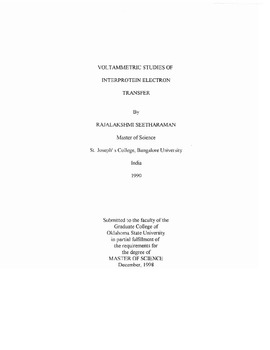| dc.description.abstract | VOLTAMMETRIC STUDIES OF INTERPROTEIN ELECTRON TRANSFER A number of chemical processes such as respiration, photosynthesis, nitrogen fixation, etc. occur in biological systems. Such reactions typically involve transfer of electrons between two redox centers. Therefore, there has been a widespread interest in developing methods to determine electron transfer rate constants between physiological partner proteins., in order to understand biological reaction rates in more detail. The electron transfer reaction for the transfer of an electron from ferrocytochrome bs (a hemecontaining protein) to ferricytochrome c has been studied by earlier approaches such as flash photolysis in 1993, formation of a photoactive .complex of cyt. bs in 1995. More recently, we proposed cyclic voltammetry as a viable approach. To this end, a mini gold electrode modified with P-mercaptopropionate, was used to determine protein-protein electron transfer rate constants. 3 When cyclic voltammetry was carried out on a solution containing a mixture of cytochrome bs, cytochrome c, and the polycation, polylysine, it was found that cytochrome bs undergoes reversible electrochemistry at the modified electrode surface, while the electrode surface discriminates against cytochrome c. Modifying the electrode surface, therefore, provides a versatile method for selectively reducing a protein possessing a relatively low reduction potential (outer mitochondrial membrane cytochrome bs, EO =-102 mV)..i!1 the presence of another protein possessing a relatively high reduction potential (horse heart cytochrome c, F:" =265 mV). This provides an alternative system for the transfer of an electron to a protein possessing a net negative charge in the presence of a protein possessing a net positive charge. An electrochemicaichemical reaction mechanism was proposed to account for the shape of the cyclic voltammogram obtained: Fe(III) cyt. bs + e' ;= Fe(I1) cyt. bs kr Fe(II) cyt. bs + Fe(III) cyt. c;= Fe(IIl) cyt. bs + Fe(D) cyt. c kb This reaction scheme was explicitly simulated, and a value of k(f) = 2.9 X 10^8 M^(-1)s^(-1) obtained, which was in good agreement with the value obtained previously by flash photolysis. I Further, cyclic voltammetric and spectroelectrochemical studies 40 fthe wild type protein and its dimethyl ester have been carried out to investigate the factors that play a role in modulating the reduction potential of the wild type protein. The results of these studies may pave way for more investigative studies to explore the possibility that the reduction potential of cytochrome bs maybe modulated upon formation of a transient complex with cytochrome c. | |
